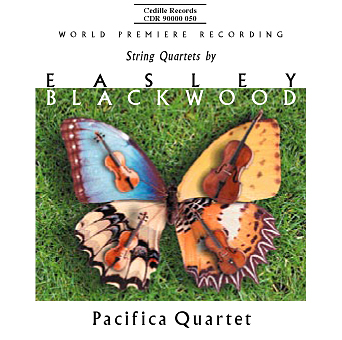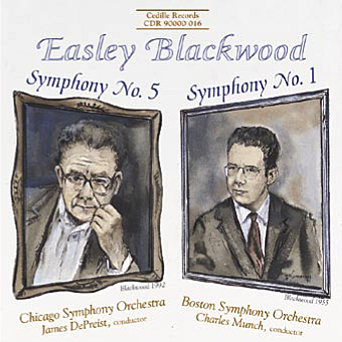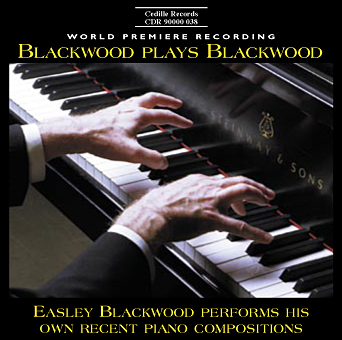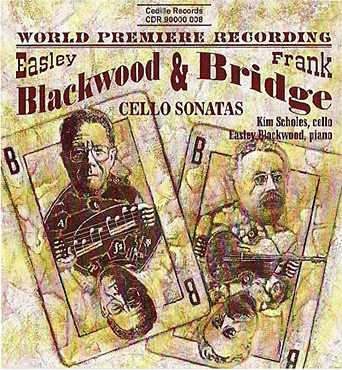Store
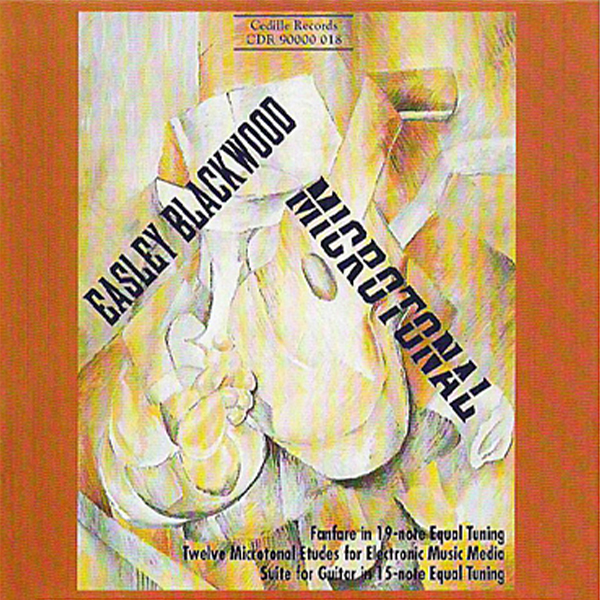
Store
Easley Blackwood: Microtonal
Easley Blackwood’s Twelve Microtonal Etudes for Electronic Music Media, a landmark exploration that drew widespread critical praise upon its release in 1980, has been reissued for the first time on compact disc. Also new on the CD are two never-before-released Blackwood microtonal works.
“Easley Blackwood has composed and produced contemporary music that is quite beautiful,” wrote Frank Peters of the St. Louis Post-Dispatch (Feb. 22, 1981) in a review of the Etudes. He described them as “music that holds the attention and stimulates the mind, music that keeps yielding new attractions after many rehearsings.”
The intriguing Etudes culminated Blackwood’s research, funded by the National Endowment for the Humanities, into the techniques and expressive possibilities of microtonal tunings. Microtonal tunings are those that divide an octave in some other manner than into 12 equal parts. Blackwood wrote études for equal tunings of 13 to 24 notes to the octave and has likened the task to writing a “sequel” to “The Well-Tempered Clavier,” JS Bach’s famous collection of preludes and fugues in each of the major and minor keys.
Blackwood let the “flavor” of each tuning suggest an established musical form or style for each étude: a Classical piano sonata (track no. 13), Russian nationalism (track no. 8), jazz (track no. 11), the sound of South Pacific gamelans (track no. 5), and the form of a Baroque violin sonata (track no. 4). This approach also allows listeners to hear how microtonal tunings affect familiar musical genres.
“He has done no less than tame the wildest musical beasts and create ideal domestic environments for them,” wrote Fanfare‘s reviewer.
“There is a crazy wit in this, as though one is following a madcap chase through a Chinese laundry of overlapping and interlocking tonalities,” wrote Conrad Cummings in the Computer Music Journal.
“It seems to me that in the long run, the microtonal scales I’ve been working with offer the most positive direction that music could go in,” Blackwood told Keyboard magazine (May 1982). “This is where there still remain things to be discovered. Attractive things to be discovered.”
The Fanfare in 19-note Equal Tuning (1981) was commissioned by Chicago fine arts radio station WFMT, along with fanfares by other Chicago-area composers, to celebrate the station’s 30th anniversary.
The Suite for Guitar in 15-note Equal Tuning makes use of the properties Blackwood discovered when he wrote the microtonal étude in 15-note tuning. It’s cast in four movements with dance-like rhythms akin to those found in Baroque suites. “For the performance of microtonal music on conventional acoustic instruments, those with fretted strings are the least problematic because the frets automatically and accurately establish the location of each pitch,” Blackwood writes in the CD booklet.
Preview Excerpts
EASLEY BLACKWOOD (b. 1933)
Twelve Microtonal Etudes for Electronic Music Media, Op. 28
Suite for Guitar in 15-note Equal Tuning, Op. 33
Artists
Program Notes
Download Album BookletMicrotonal
Notes by Easley Blackwood
I composed the Twelve Microtonal Etudes for Electronic Music Media in 1979 and 1980 as illustrations of a research project funded by the National Endowment for the Humanities in conjunction with Webster College, St. Louis. The project was to explore the tonal and modal behavior of all the equal tunings of 13 through 24 notes (to the octave), devise a notation for each tuning, and write a composition in each tuning to illustrate good chord progressions and the practical application of the notation.
“Microtonal” tunings are those that divide an octave in some other manner than into twelve equal parts. While interest in microtonal music is as old as music itself, it has only recently become practical to explore microtonal tunings in any systematic way; before the development of sophisticated miniaturized electronic devices, the process was too slow and inaccurate.
Why should one compose in equal tunings of 13 through 24 notes when some of these tunings sound decidedly out of tune and have previously been regarded as of little or no musical utility? Long before I began the Microtonal Etudes project, I doubted the wisdom of theorists who rejected out of hand any tuning that did not produce consonant triads. Only when I began this study, however, did I discover the vast musical possibilities inherent in different equal tunings. I believe these Etudes prove that equal tunings of more than twelve notes can indeed produce expressively compelling progressions of hitherto alien harmonies and modes.
I chose to restrict my research to equal tunings primarily because so many aspects of chromatic harmony are associated exclusively with equal tunings. These include the behavior of a closed circle of fifths or other intervals, different equal divisions of the common intervals of diatonic harmony, and the capability of transposition into as many different registers as there are notes in the tuning. In addition, all twelve tunings explored here permit modal arrangements in which modulations can be clearly perceived.
The most challenging aspect of the entire study was the development of a notation that both reveals the modal configurations inherent within each tuning and conforms to the habits of a trained musician. In all cases, I preserved the five-line staff, and octaves are written as we are accustomed to seeing them. Within each octave, the behavior of accidentals differs from tuning to tuning. In some cases, I had to introduce up to two new symbols. Within this framework, the Etudes, and all the works on this recording, are completely written out; there are no improvisatory or aleatoric elements to these works.
The only workable medium for the realization of the Etudes — and the Fanfare in 19-note equal tuning, composed in 1981 — is a combination of electronic instruments, either in part-by-part synthesis with multiple track recording, or in live performance. I would love to hear someone else’s interpretation of these scores. Taping them was not a simple process, however: recording the Twelve Microtonal Etudes required thirteen day-long sessions which took place between March 1979 and July 1980.
Aside from their theoretically illustrative value, I intend for these Etudes to stand on their own merit as musical compositions. My purpose was to express what is inherent in each tuning by the most attractive possible musical design. I tried to discover the most appealing arrangements within each tuning — chord progressions that should become standard formulas if and when the tunings come into more widespread use.
The musical behavior of each tuning is best described with reference to the individual Microtonal Etudes.
16 notes: This tuning is best thought of as a combination of four intertwined diminished seventh chords. Since 12-note tuning can be regarded as a combination of three diminished seventh chords, it is plain that the two tunings have elements in common. The most obvious difference in the way the two tunings sound and work is that triads in 16- note tuning, although recognizable, are too discordant to serve as the final harmony in cadences. Keys can still be established by successions of altered subdominant and dominant harmonies, however, and the Etude is based mainly upon this property. The fundamental consonant harmony employed is a minor triad with an added minor seventh.
18 notes: This tuning also contains elements in common with 12-note tuning as it is a combination of three intertwined whole-tone scales. However, perfect fifths are so out of tune here that even seventh chords are disturbingly discordant. Hence, the harmonic vocabulary of the Etude consists mainly of altered chords in which most of the notes come from one of the three whole tone scales. Even these harmonies are picantly discordant enough to require elaborate overlays of parts to sound acceptable.
21 notes: Major and minor triads and keys are relatively consonant here. Scales sound somewhat out of tune, however, due to the impossibility of dividing a major third into two equal parts. Triads may be arranged into chromatic circular modulations involving seven repetitions proceeding up or down by seconds, thirds, or fourths. The movements of the Suite exploit this feature in different ways, using canonic ornamentation. The first movement makes use of a canon at the fourth; the second, a Gavotte, features a canon at the second; the third movement includes a canon at the third; and in the final Gigue, the canon is in contrary motion.
23 notes: A particular challenge, 23-note tuning contains no diatonic configurations and no chromatic structures in common with any of the other tunings explored in this study. However, it does contain an intriguing arrangement of the two distinct pentatonic modes of Java and Bali, known as pelog and slendro — modes that cannot be realistically approximated in 12-note tuning. The Etude alternates the two modes with occasional chromatic modulations and the addition of dissonant tones.
13 notes: The most alien tuning of all: so dissonant that no three-note combination sounds like a major or minor triad. Yet even this tuning contains a strange mode best described as “sub-minor”. The first four bars of the Etude are an arrangement of this mode into consecutive thirds — a motif that recurs later in two transposed variations. The rest of the piece is comprised of chromatic resolutions of complex altered chords.
15 notes: One of the most fascinating of the equal tunings, this contains triads that are sufficiently in tune to serve as the final harmony in cadences. The major scale, however, is so strange that even the most common diatonic progressions are disturbing unless precautions are taken. Fortunately, 15-note triads may be arranged into chromatic progressions wholly different from those available in 12- note tuning. These progressions involve the division of the octave into five equal parts, which is only possible in tunings where the number of notes is divisible by five. The Etude makes extensive use of triads placed over this division in various arrangements.
17 notes: This tuning has much in common with 12-note tuning because both contain diatonic scales of five equal major seconds and two equal minor seconds. In 17-note tuning, however, each major second spans three chromatic degrees rather than two (as in 12-note tuning); in both tunings minor seconds span one chromatic degree. 17-note triads are very discordant due to the large major third, so the fundamental consonant harmony of the tuning is a minor triad with an added minor seventh. The scale is very good due to the relatively small minor second, and minor seventh chords may serve as tonics in the Dorian, Phrygian, and Aeolian modes. The Etude consists largely of passages in these modes connected by chromatic modulations unique to 17-note tuning.
22 notes: This tuning contains triads that are very smooth — in some respects, even a bit smoother than those of 12- note tuning. The smoothness of the triads is offset, however, by the out-of-tune scale which sharply restricts the tuning’s diatonic vocabulary. Along with its pleasing triads, the tuning offers very concordant versions of dominant sevenths, augmented sixths, and other altered chords which can be arranged into fascinating chromatic progressions. Structurally, the Etude is a fugue with two subjects: the first diatonic, the second chromatic. Toward the end, the two are combined in three different harmonizations featuring invertible counterpoint.
24 notes: This familiar “quarter-tone” tuning is actually one of the most difficult to deal with in a practical situation. Without exception, the notes “in the cracks” make extreme discords with the other notes, and there are very few satisfactory harmonies that combine the two. The two intertwined sets of twelve notes may be alternated with good effect, and the Etude exploits that property. Formally, it is a passacaglia in which the theme is initially heard five times in the bass, with a new part added at each new variation, the last three of which place the theme in successively higher registers.
14 notes: This very discordant tuning offers two highly contrasting modal arrangements. One is the division of an octave into seven equal parts, sounding like a diatonic scale with no distinctions of major or minor. The other is a combination of two differently tuned diminished seventh chords. The Etude alternates two themes, one in each mode, in a highly syncopated idiom.
20 notes: The modal arrangements of this tuning are very complex, and have their origin in the equal divisions of an octave into four and five parts. Triads are very bad, and the most consonant harmony this tuning offers is a minor triad with an added major sixth, along with its inversions. This is the main harmonic unit of the Etude, which also makes melodic use of the division of an octave into five equal parts.
19 notes: This tuning contains diatonic scales in which the major second spans three chromatic degrees, and the minor second two. Triads are smooth, but the scale sounds slightly out of tune because the leading tone seems low with respect to the tonic. Diatonic behavior is virtually identical to that of 12-note tuning, but chromatic behavior is very different. For example, a perfect fourth is divisible into two equal parts, while an augmented sixth and a diminished seventh sound identical. The Etude is in sonata form where the first theme is diatonic and the second is chromatic. The development modulates entirely around the circle of nineteen fifths. An extended coda employs both diatonic and chromatic elements.
The Fanfare in 19-note Equal Tuning was commissioned by Chicago fine arts radio station WFMT, along with fanfares by other Chicago-area composers, to celebrate its 30th anniversary. To portray the festive nature of the occasion, the Fanfare makes extensive use of the characteristically superior consonance of 19-note major triads, often arranged into expansive sonorities and embellished by antiphonal flourishes. The entire piece is built around a rapidly modulating succession of major keys in which the new tonics are immediately and clearly expressed.
For the performance of microtonal music on conventional acoustic instruments, those with fretted strings are the least problematic because the frets automatically and accurately establish the location of each pitch. In 15-note tuning, a perfect fourth is slightly smaller than its 12-note counterpart, such that five 15-note perfect fourths span two octaves exactly. Hence, the open strings of the guitar are tuned so that each adjacent pair makes one of these reduced perfect fourths, and the sixth fret on each string produces the same pitch as the open string immediately above. Mr. Kust says he became accustomed to the new dimensions far more easily than he expected. He also found very helpful an electronic simulation of the piece in true tempo, half tempo, and quarter tempo.
The guitar piece makes use of the properties I discovered when I wrote the microtonal Etude in 15-note tuning. It is cast in four movements with dance-like rhythms akin to those found in Baroque suites.
— Easley Blackwood
Album Details
Total Time: 56:00
Recorded: Tracks 1-13: Made from master recordings owned by Easley Blackwood and recorded 1979-81 at Sound 80, Minneapolis.
Programmer: Roger Dumas
Engineer: Scott Rivard
Recorded: Tracks 14-17; September 16, 1990 at WFMT Chicago
Producer: James Ginsburg
Engineer: Bill Maylone
Cover: Guitar and Fruit Dish (Georges Braque, 1909) © 1994 ARS NY/ADAGP
Design: Cheryl A Boncuore
Notes: Easley Blackwood
© 1994 Cedille Records/Cedille Chicago
CDR 90000 018
